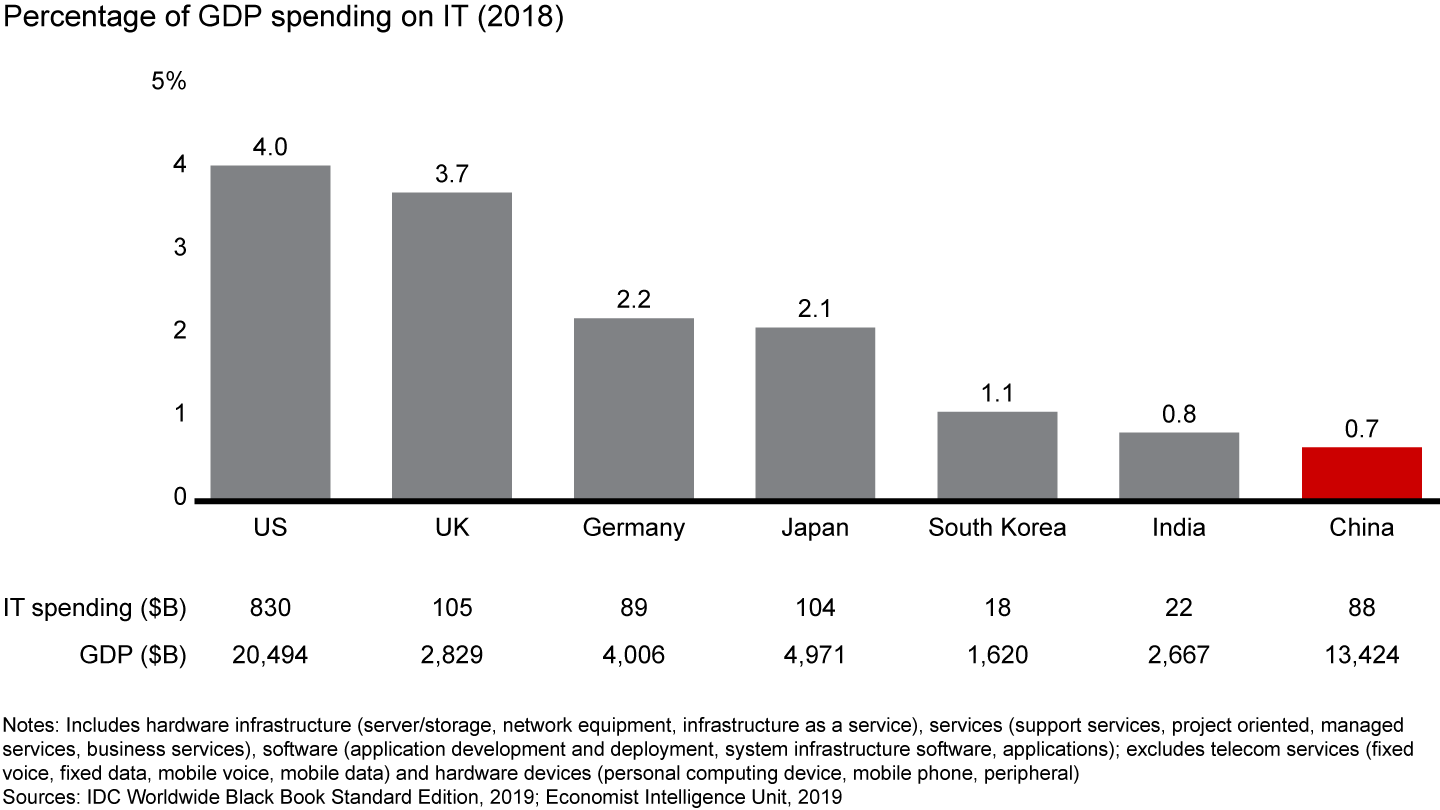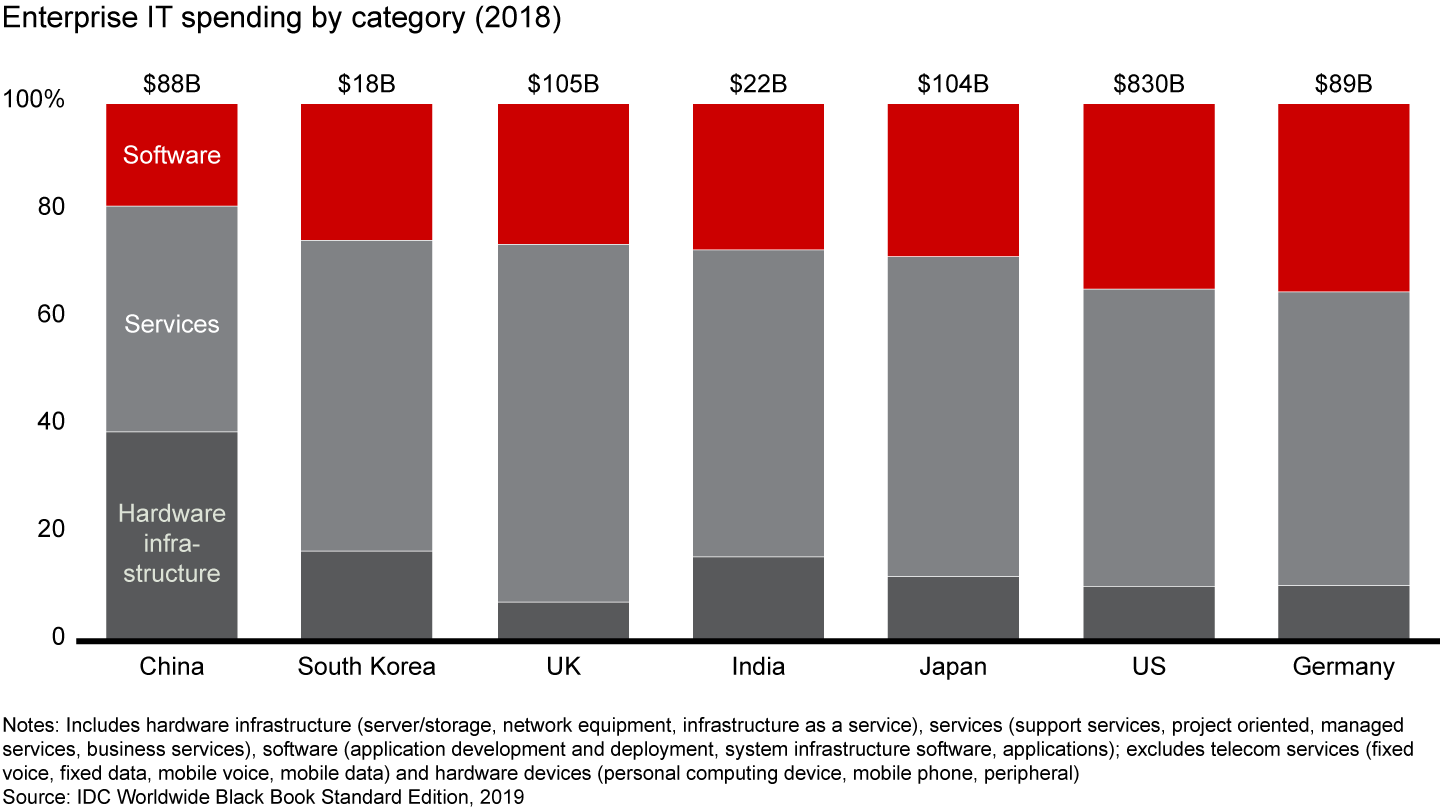Article
 }
}
This is the fifth in a series of posts on the enterprise cloud market—its economics, customer segments and the opportunities for technology providers.
China’s cloud market is growing rapidly. Aliyun (also known as Alibaba Cloud) has the lion’s share of growth, with 42% of the public cloud marketplace in 2018, per IDC. Tencent Cloud serves 12%, followed by China Telecom at 9% and Amazon Web Services close behind with 6%.
But executives of non-Chinese firms selling cloud hardware, software and services remain unsure about how they can participate in China’s cloud market. They know that it doesn’t look like the cloud markets of North America, Europe and the rest of Asia. Different spending patterns and a legacy of companies using unlicensed software has shaped China’s IT market and will shape cloud adoption there (see Figure 1). The playbooks that international vendors use elsewhere won’t work in China, so they need to develop new approaches.


Cloud’s rapid rise in North America and Europe owes much to the software-as-a-service (SaaS) model, which saw enterprises shift to the cloud to reduce their up-front costs for new software. Signing up for new services at a subscription level rather than buying on-premise licenses converts capex to opex and lets companies access new functionality without large up-front payments. Subscription fees may look small compared with license fees, but for companies in China that are accustomed to paying much less (or nothing) for their software, even small fees add cost.
Even if China’s cloud market looks challenging compared with Western markets, it still represents new opportunity: Whereas many companies were accustomed to paying nothing for software, the switch to SaaS means many will decide to (or be forced to) spend to access the latest software, which can only be accessed by subscription. For SaaS to succeed in China, it needs to offer enough new value for China’s companies to see the subscription price as a worthy investment.
Three characteristics of China’s cloud market may help enterprise vendors navigate their approach.
- Because China’s businesses spend far less on software, China has an underdeveloped ecosystem of software architects, developers and administrators. One way to measure this is by the mix of spending across hardware, software and services (see Figure 2). Every dollar spent on hardware infrastructure in the US supports more than three dollars of software spending, while a dollar spent on hardware in China generates only about 50 cents worth of software spending.


- State-owned enterprises account for a large share of total IT spending and are highly concentrated in government, banking and financial services. In these sectors, most IT spending focuses on large, complex, highly integrated legacy systems that cannot easily move to the cloud. A large and dynamic start-up scene has emerged in China, and it is spending on the cloud. However, that still represents only a small fraction of total IT spending. In the US, cloud providers are addressing mainstream companies across industries, but that’s harder to do in an economy dominated by state-owned enterprises.
- Technology localization campaigns that have been underway for years continue to limit the appetite among China’s firms, large and small, for comprehensive solutions from Western companies. China’s technology sector continues to improve its ability to deliver services and quality levels that are comparable with their Western counterparts. For example, Alibaba’s Ding Ding (also known as DingTalk), a cloud-based system for workplace communication, has more than 100 million users across 7 million companies in China—and it’s free.
All of these factors suggest that China’s cloud market will develop more slowly than cloud markets in Europe and North America. Uncertainty in the trade relationship between China and the US will further complicate the process, and could slow the growth curve. China’s cloud market is likely to remain small for international vendors, and the gap between sales to the North American market and sales to China could take a very long time to close.

Mastering the Cloud Economy
Technology providers selling cloud software, services and hardware can strengthen their value proposition by developing a better understanding of cloud economics, customer preferences, and the impact of the cloud’s ascendance in legacy and disruptive technologies.